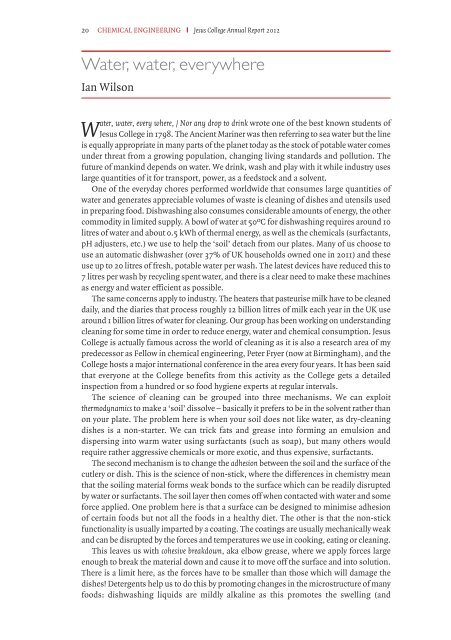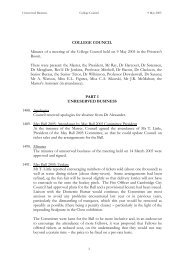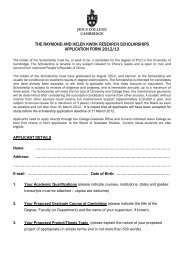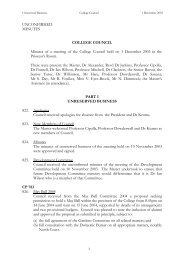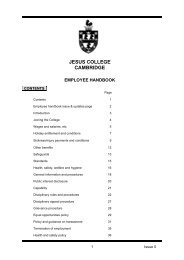2012 Annual Report - Jesus College - University of Cambridge
2012 Annual Report - Jesus College - University of Cambridge
2012 Annual Report - Jesus College - University of Cambridge
Create successful ePaper yourself
Turn your PDF publications into a flip-book with our unique Google optimized e-Paper software.
20 CHEMICAL ENGINEERING I <strong>Jesus</strong> <strong>College</strong> <strong>Annual</strong> <strong>Report</strong> <strong>2012</strong><br />
Water, water, everywhere<br />
Ian Wilson<br />
Water, water, every where, / Nor any drop to drink wrote one <strong>of</strong> the best known students <strong>of</strong><br />
<strong>Jesus</strong> <strong>College</strong> in 1798. The Ancient Mariner was then referring to sea water but the line<br />
is equally appropriate in many parts <strong>of</strong> the planet today as the stock <strong>of</strong> potable water comes<br />
under threat from a growing population, changing living standards and pollution. The<br />
future <strong>of</strong> mankind depends on water. We drink, wash and play with it while industry uses<br />
large quantities <strong>of</strong> it for transport, power, as a feedstock and a solvent.<br />
One <strong>of</strong> the everyday chores performed worldwide that consumes large quantities <strong>of</strong><br />
water and generates appreciable volumes <strong>of</strong> waste is cleaning <strong>of</strong> dishes and utensils used<br />
in preparing food. Dishwashing also consumes considerable amounts <strong>of</strong> energy, the other<br />
commodity in limited supply. A bowl <strong>of</strong> water at 50ºC for dishwashing requires around 10<br />
litres <strong>of</strong> water and about 0.5 kWh <strong>of</strong> thermal energy, as well as the chemicals (surfactants,<br />
pH adjusters, etc.) we use to help the ‘soil’ detach from our plates. Many <strong>of</strong> us choose to<br />
use an automatic dishwasher (over 37% <strong>of</strong> UK households owned one in 2011) and these<br />
use up to 20 litres <strong>of</strong> fresh, potable water per wash. The latest devices have reduced this to<br />
7 litres per wash by recycling spent water, and there is a clear need to make these machines<br />
as energy and water efficient as possible.<br />
The same concerns apply to industry. The heaters that pasteurise milk have to be cleaned<br />
daily, and the diaries that process roughly 12 billion litres <strong>of</strong> milk each year in the UK use<br />
around 1 billion litres <strong>of</strong> water for cleaning. Our group has been working on understanding<br />
cleaning for some time in order to reduce energy, water and chemical consumption. <strong>Jesus</strong><br />
<strong>College</strong> is actually famous across the world <strong>of</strong> cleaning as it is also a research area <strong>of</strong> my<br />
predecessor as Fellow in chemical engineering, Peter Fryer (now at Birmingham), and the<br />
<strong>College</strong> hosts a major international conference in the area every four years. It has been said<br />
that everyone at the <strong>College</strong> benefits from this activity as the <strong>College</strong> gets a detailed<br />
inspection from a hundred or so food hygiene experts at regular intervals.<br />
The science <strong>of</strong> cleaning can be grouped into three mechanisms. We can exploit<br />
thermodynamics to make a ‘soil’ dissolve – basically it prefers to be in the solvent rather than<br />
on your plate. The problem here is when your soil does not like water, as dry-cleaning<br />
dishes is a non-starter. We can trick fats and grease into forming an emulsion and<br />
dispersing into warm water using surfactants (such as soap), but many others would<br />
require rather aggressive chemicals or more exotic, and thus expensive, surfactants.<br />
The second mechanism is to change the adhesion between the soil and the surface <strong>of</strong> the<br />
cutlery or dish. This is the science <strong>of</strong> non-stick, where the differences in chemistry mean<br />
that the soiling material forms weak bonds to the surface which can be readily disrupted<br />
by water or surfactants. The soil layer then comes <strong>of</strong>f when contacted with water and some<br />
force applied. One problem here is that a surface can be designed to minimise adhesion<br />
<strong>of</strong> certain foods but not all the foods in a healthy diet. The other is that the non-stick<br />
functionality is usually imparted by a coating. The coatings are usually mechanically weak<br />
and can be disrupted by the forces and temperatures we use in cooking, eating or cleaning.<br />
This leaves us with cohesive breakdown, aka elbow grease, where we apply forces large<br />
enough to break the material down and cause it to move <strong>of</strong>f the surface and into solution.<br />
There is a limit here, as the forces have to be smaller than those which will damage the<br />
dishes! Detergents help us to do this by promoting changes in the microstructure <strong>of</strong> many<br />
foods: dishwashing liquids are mildly alkaline as this promotes the swelling (and


